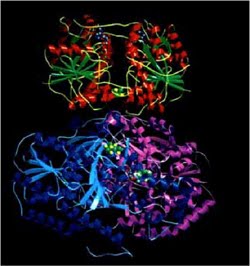This article from the online entity of Science, published by the American Association for the Advancement of Science, is yet more proof of the foundation of biodevelopment--intelligent molecules (see the main article on biodevelopment here).
'Human cells contain tens of thousands of protein-encoding genes that are transcribed into a much larger numbers of mRNAs. Viruses, on the other hand, are far simpler, carrying with them only a handful of genes and proteins, yet they have developed countless ways of hijacking specific host cellular functions for their own benefit. Discovering these survival mechanisms often offers fascinating insights into normal host cell biology. Eukaryotes use sophisticated ways of regulating gene expression, including polyadenylating the 3' end of mRNAs to enhance their stability for eventual translation into protein, and possibly also to promote mRNA degradation. Some herpesviruses, including Kaposi's sarcoma-associated herpesvirus (KSHV), manipulate host cells by promoting the widespread destruction of cellular mRNAs. KSHV achieves this via its Sox protein, and Lee and Glaunsinger show that human cells expressing the viral Sox protein contain mRNAs with unusually long poly(A) tails (hyperadenylation), which was mediated by the host enzyme poly(A) polymerase II. This effect of viral Sox was linked to its ability to accelerate mRNA turnover, suggesting that the virus induces host mRNA degradation by modulating poly(A) length.' PLoS Biol. 7, e1000107 (2009).
Added to that is this article in ScienceDaily, which shows that bacteria can plan ahead.
(Too many humans cannot plan a bunion, let alone a head.)
Tuesday, June 23, 2009
Subscribe to:
Posts (Atom)


